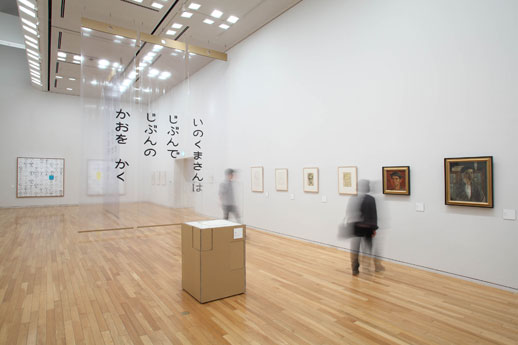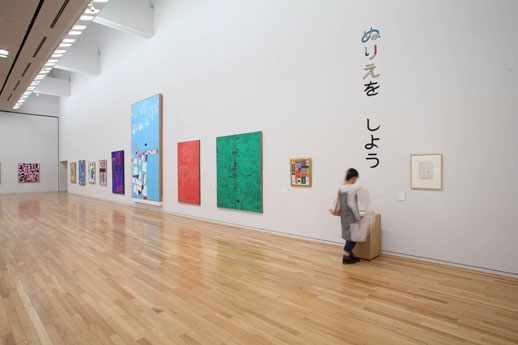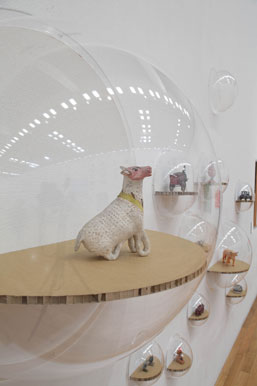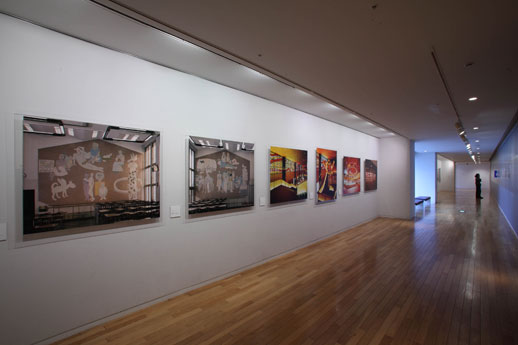Voice of Childhood and Evolution
As a child I grew up in a large house, filled with many rooms and corridors, each with their secrets and quiet whispers of history. Childhood innocence gives a certain grandeur to the mundane; stories, vases, toys, all gain a touch of sentimentality from the perspective of youth. The younger you are, the more vacuous the memory; fleeting in form and shape, a dull spark in the blackness of your mind’s void. This to me is the essence of Genichiro Inokuma’s work; art that rises and falls in pulses like faded memories; some bright, some dark with just enough grey in between.
As I entered the gallery area, a large cardboard motif with “Inokuma-san” written in massive hiragana sets the tone for the exhibition. Many exhibits from contemporary artists are locked into a mood; tragedy, inspiration or nothing at all, centered around a theme that is obvious to the viewer like explicit sexual photography, or paintings made with real blood. The voice of Inokuma’s exhibit is one of evolution. There are pieces on display from his early youth, ‘Fans, Samurai’ (1913), up until his death ‘Space City Holiday’(1993). His artistic style is simple, with light sketches from old sketch books framed to look like premeditated pieces and half-finished works centered in large transparent displays throughout the viewing area.

His simplistic style of drawing connotes a certain transparency in his personality, which is reflected in the exhibit’s interior design. Huge sheets of clear plastic with little quotes about Inokuma written in large, black hiragana hang from the roof’s ceiling, forming a gently guiding path for you to follow throughout the gallery.
His art is a series of thin lines and light features. In fact, his most detailed paintings in the entire gallery of over 100 works are those of himself. Two portraits, depicting him with a quiet, friendly expression, are quite vivid. There are six of them as you enter the gallery, which fade in detail from first to last. The first two portraits are heavy on painting style and realism, with the others being flat, light sketches. The final one is an image of himself from behind; obscure, older and looking at something we’ll never see.

Despite his obvious skill of rendering real images, Inokuma’s work has a solidly childlike feel. ‘Faces’,’30 Faces’, and ’80 Faces’ are perfect examples of this. Simple oval faces that resemble scrawling from a children’s exercise book are delicately arranged in a gallery of increasingly multiplistic works, all faces. Hauntingly quiet and nigh expressionless, they are rather androgynous and each bear a striking resemblance to contemporary renderings of extra-terrestrial beings. There are no bodies on these mysterious persons, with the only exception being the occasional appearance of a naked female, on some of the works. This naked woman appears throughout various works in the gallery, particularly in those with many animals. This idea of multiplicity continues as Inokuma’s canvases transition from faces to animals. ‘Life of Bird’ (1986) takes me back to classrooms after school, when one can see the anonymous work of a student artist on the blackboard, forever immortalized in chalk. An untitled image from 1992 has over thirty birds, all drawn in similar positions, resembling a swarm of bees drawn with almost no detail.
 ‘Cats’ (1953) is another look into the corridor of Inokuma’s mind. This painting has a striking simplicity, which, quite like gourmet food, has elegance, an air. This painting has thin caricatures of cats with squares for heads and perfectly circular eyes, with such little detail the cats seem as blank as the canvas, staring back at you from a void.
‘Cats’ (1953) is another look into the corridor of Inokuma’s mind. This painting has a striking simplicity, which, quite like gourmet food, has elegance, an air. This painting has thin caricatures of cats with squares for heads and perfectly circular eyes, with such little detail the cats seem as blank as the canvas, staring back at you from a void.
The multitude of faces and animals in his works can give a sense of detachment from humanity when viewed bolstered by the fact that ‘Portrait of Mr.S’ and ‘Cherries’ are the only two works in the gallery that depict any person other than Inokuma himself.
If Calliope music was the theme for the first two exhibits in the gallery, a good Glam Rock album would fit the play list of Inokuma’s more abstract works. Powerfully bright and expressive, these paintings use mostly polygonal shapes to represent ideas inferenced by the titles of the works. ‘Unique Friend’, ‘Space is a Playground’, ‘Machines’ and ‘Space City Holiday’ are acrylic flotillas of questions in color. It is tempting to think that Inokuma is asking questions about the nature of reality through his space-oriented paintings, but like our actual knowledge of the universe, most of what we see is highly interpretive and subjective.
Animals are a definite stamp on the face of Inokuma’s works. A series of them are displayed in a simple menagerie of plastic bubbles, quite resembling the finished work of a skilled taxidermist. Mostly lounging or standing in normal positions, the creatures aren’t striking in appearance, but modular and friendly. The gallery grows in scale near to its end, with displays of Inokuma’s larger works created later in his adult life. ‘Freedom’,’Democracy’,’Living for Tomorrow’ and ‘The Birth of the Robot’ all have that Inokuma feel; colorful abstracts of massive paintings of people with simple features. His growth as an artist is impressive, especially ‘Occasional Ribbon’, and ‘The Golden Ring’ sculptures made for the delicate tastes of the bourgeoisie.
A small pastel colored box under a painting had copies of the painting above it freely available. “Take one please” the text said. On it, was a sketch that seemed like it could have belong to anyone. I for one, think Inokuma would have liked it that way.

Marcus Bird
Marcus Bird



